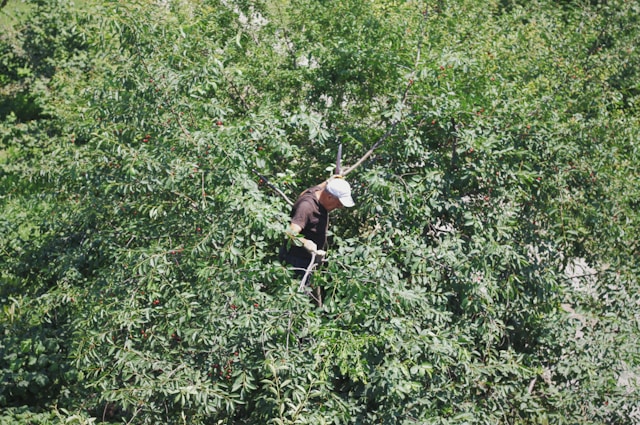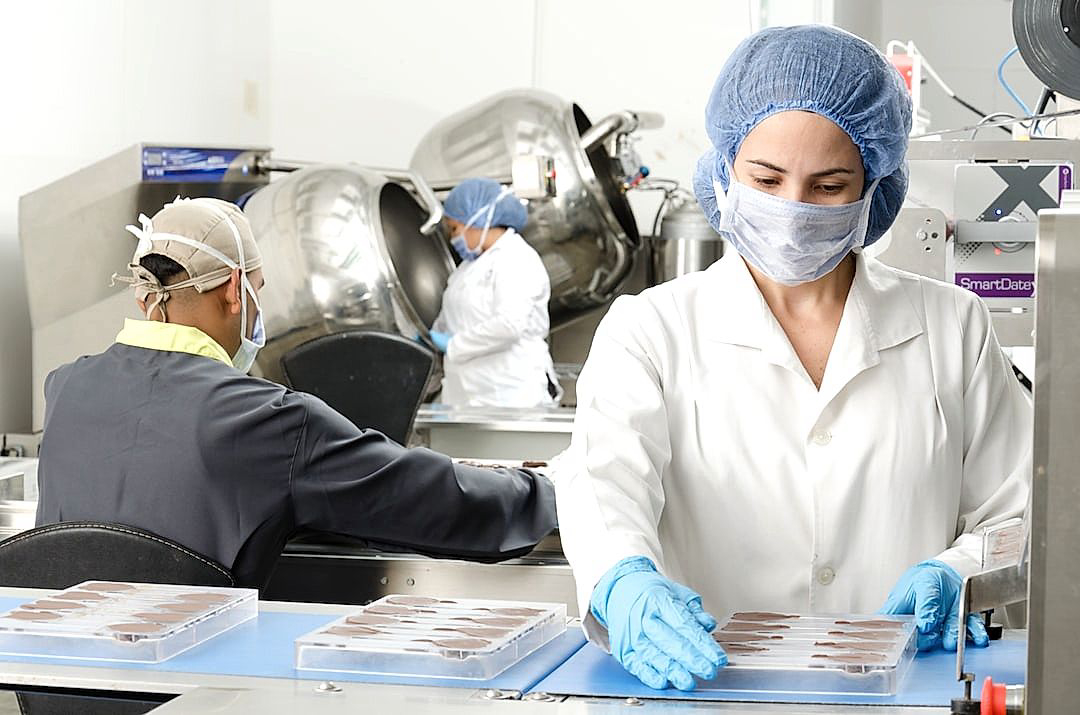Ensuring safe working conditions and the maintenance of sanitary, hazard-free environments within farming operations is paramount.
It’s an often overlooked aspect of farming that directly affects both workers and consumers alike.
Proper safety protocols can both protect employees from harm and ensure the production of wholesome, contaminant-free food.
Yet, it’s an area that needs more diligent attention across the agricultural industry.
Increasing awareness about these safety measures is crucial for sustainable, safe farming.
The aim of this discussion is to shed light on necessary safety measures in produce farming, boosting both worker welfare and consumer trust.
Contents [hide]
- Safety Protocols For Produce Farming Operations
- 1. Provide personal protective equipment (PPE) for all employees.
- 2. Train Staff in Correct Hand Washing Procedures
- 3. Enforce safe equipment and machinery handling.
- 4. Regularly inspect and maintain farm equipment.
- 5. Implement Proper Pesticide Handling and Application
- 6. Ensure safe storage of harmful chemicals.
- 7. Maintain clean, sanitized packaging and storage areas
- 8. Implement Safe Waste Disposal Procedures
- 9. Ensure Adequate Food Safety Training
- 10. Implement Regular Health and Safety Inspections
- The Bottom Line
Safety Protocols For Produce Farming Operations
1. Provide personal protective equipment (PPE) for all employees.
Providing personal protective equipment (PPE) for all employees is a critical part of any safety protocol, especially in produce farming operations.
By definition, PPE refers to protective clothing, helmets, goggles, or other garments or equipment designed to protect the wearer’s body from injury or infection.
The hazards addressed by protective equipment include physical, electrical, heat, chemical, biohazards, and airborne particulate matter.
In the context of produce farming operations, PPE can take different forms depending on the specific tasks that workers are performing.
For instance, workers who are involved in the application of pesticides may need to wear protective suits, gloves, and masks to prevent skin and respiratory exposure to these chemicals.
Moreover, those who operate heavy machinery may need to wear safety boots and helmets to protect themselves from potential injuries.
It’s crucial to note that merely providing PPE is not enough. Farmers must also ensure that they are providing the correct PPE for each specific task, and that workers are correctly using this equipment.
Furthermore, these protective gears must meet the standards specified by the relevant safety regulation of the territory or country.
Workers should be adequately trained on the correct use and maintenance of their PPE to maximize its effectiveness in protecting them from harm.
In many areas, farm owners are legally obligated to provide their workers with the appropriate PPE and to ensure that these are worn properly at all times.
However, they should understand that following these regulations is not only a legal requirement but also a moral responsibility towards their workers.
Failure to provide or ensure the proper use of PPE can lead to severe consequences, including workplace injuries and litigations.
Finally, given the often harsh and unpredictable conditions of farming, regular inspection and replacement of PPE is vital to ensure its ongoing effectiveness in providing protection.
PPE is undoubtedly a crucial tool in maintaining farm safety, but it must be used in conjunction with other safety practices such as training and regular inspections to create a truly safe farming environment.
2. Train Staff in Correct Hand Washing Procedures
One of the most straightforward and effective ways to ensure safety within a farming operation is to properly train staff in disease prevention practices, of which handwashing is paramount.
Hand hygiene is a primary measure to reduce infections and the spread of diseases on produce farms.
It is crucial to be clear that handwashing doesn’t only involve water.
The usage of soap and the proper technique is equally important in making this safety practice effective.
It is a key element in preventing cross-contamination among workers and between them and the products that they handle.
Trainings must be comprehensive and include a detailed process, demonstrations, and ways to ensure that all employees understand and commit to the procedure.
Importantly, handwashing practices should be implemented before and after handling produce, handling raw food, touching animals, and other potentially contaminating tasks.
Workers should also wash their hands after using the toilet, smoking or taking breaks, touching waste, etc.
Facilities for washing, drying, and disinfecting hands should be conveniently located and well maintained.
The usage of soap, running water, and single-use towels must be encouraged.
It is crucial to emphasize that handwashing is not optional, but a part of the job.
Regular checks should be implemented to ensure correct technique and consistency in hand hygiene practices.
Refresher courses on the importance of proper hand hygiene and the correct handwashing procedure could be conducted periodically, reinforcing its importance.
Rewards and recognition could be implemented for those who adhere to optimal hand hygiene practices, driving further compliance.
Lastly, informational materials such as charts and posters displaying correct handwashing procedures should be present near all handwashing stations.
With these measures in place, handwashing can be turned into a habitual action for everyone working on your farm, and it will provide substantial enhancement to the overall safety of your agricultural operation._
3. Enforce safe equipment and machinery handling.
The use of machinery and equipment in produce farming operations is often inevitable, and therefore, the enforcement of safe handling practices is of utmost importance.
Unsafe machinery handling poses a considerable threat, not just to the users, but to the entire farm operation, leading to crippling productivity and financial losses.
To mitigate these risks, produce farms must establish strict safety protocols related to machinery use.
Firstly, every farm worker who operates any machinery should have completed a comprehensive equipment safety training.
Such trainings must not only cover the safe operation of the machinery but also the proper handling, maintenance, and storage of the same.
After these initial trainings, regular refresher courses and drills are also necessary to ensure that the learned safety practices become second nature to the farm workers.
Moreover, the responsibility of safe machinery operation does not rest solely with the worker; the management must actively monitor and enforce these safe handling rules.
Unplanned inspections, routine equipment checks, and proper documentation of machine usage and maintenance can help in improving accountability and compliance among employees.
On a related note, machinery condition plays a vast role in ensuring safe handling; therefore, it is in the farm management’s best interest to invest in quality equipment.
High-quality equipment is not just more durable and efficient but also simplifies safe handling due to the incorporation of advanced safety features.
It is also essential to keep all equipment in optimum working condition by scheduling frequent maintenance checks.
From time to time, old equipment must be retire or upgrade to align with safety norms and industry advancements.
Similarly, the use of appropriate personal protective equipment (PPE) should be mandated when operating potent machinery to minimize the potential impacts of any accidents.
In essence, the enforcement of safe equipment and handling in produce farming operations is about creating a pattern of consistent, proactive safety steps, which can not only prevent accidents but also foster a safety-first culture on the farm.
Therefore, make the topic of machine safety a priority in your produce farming operations, as it is not just about ensuring employee safety but also the long-term sustainability of the farm business.
4. Regularly inspect and maintain farm equipment.
Ensuring the safety of farming practices means going beyond just personal protective equipment (PPE) and proper handling techniques, it also includes regular inspection and maintenance of the farm equipment.
In many cases, accidents on the farm are a direct result of equipment malfunction or failure, which could often be prevented by regular and thorough maintenance checks.
Equipment inspections should be scheduled on a regular basis and not just done sporadically.
It’s important to note that inspections should not merely be cursory overviews of the equipment, but intense checks that take into account every nook and cranny of each machinery.
During these regular checks, it’s not just the functionality that should be taken into consideration, but also the safety of the equipment operation.
Ensuring all safety systems and features are in operation, from seatbelts on tractors to safety guards on saws, is a crucial aspect of regular inspections.
To facilitate consistent checks, it can be beneficial to have a meticulously recorded checklist that covers all aspects of the machinery’s operation, safety features, cleanliness, and overall effectiveness.
This checklist will serve as a guide to what needs to be checked and what standards each equipment must meet to be considered safe for use.
When any equipment fails to meet the safety criteria, it should be promptly taken out of operation, tagged for repair and should not be used until it is fixed and re-inspected for safety.
Furthermore, the equipment maintenance should not merely be a reactive measure— it should also be proactive.
Aging equipment should be evaluated regularly for potential breakdowns, and preventive maintenance measures should be taken to preemptively address these issues.
Also, it is important to remember that the responsibility of machine safety is not limited to the management alone.
All staff members operating the machinery should be trained in spotting potential issues and malfunctions.
They should also be encouraged to report these potential hazards without fear of backlash.
Through regular inspections and well-implemented maintenance procedures, a great deal of farm-related incidences and equipment failures can be avoided, making the produce farming procedures much safer and efficient.
Ultimately, ensuring safe farming operations involves a lot of elements, and regular inspection and maintenance of farm equipment plays an instrumental role in the process.
5. Implement Proper Pesticide Handling and Application
Implementing proper pesticide handling and application is of paramount importance in ensuring safety in produce farming operations.
The misuse of pesticides can lead to harmful or even fatal consequences for both personnel and the environment.
Employee training programs should heavily emphasize the correct procedures for pesticide handling and application.
Providing on-hand safety kits, such as gloves, goggles, and masks can be beneficial in safeguarding against accidental direct exposure to pesticides.
All employees should be thoroughly trained on how to correctly mix pesticides, how much to apply, and where appropriately to use them.
This step is crucial in preventing the excessive use of pesticides, which can permeate into the produce, soils and eventually trickle down to water bodies, thereby harming the ecosystem.
In addition, farmers should be well trained to handle any potential pesticide spills or accidents.
Having a robust emergency response plan can minimize environmental damage and promote faster recovery.
It’s also important to prioritize the use of safer, eco-friendly solutions for pest control, such as biopesticides.
This reduces our dependency on harsh synthetic pesticides, which can cause various health and environmental issues.
Another significant aspect of proper pesticide handling is storage.
Pesticides should be stored in a cool, dry, well-ventilated area, away from livestock, equipment, and other chemical substances.
They should be kept in securely sealed containers to prevent leaks and spills.
Correct labeling of pesticides can also prevent confusion and potential misuse, thus further promoting safety in the farming operations.
Pesticide disposal should be handled with utmost care to prevent unintended exposure and environmental contamination.
It should involve processes, such as disposal of empty pesticide containers, left-over pesticides, and any distribution equipment used.
6. Ensure safe storage of harmful chemicals.
Handling chemicals safely is a paramount detail in maintaining the wellbeing of farmworkers in produce farming operations.
Proper storage of these potentially harmful substances is pivotal to that safety.
It is important to understand that each chemical used in farming has its unique storage requirements.
These requirements are typically detailed by the manufacturer and should be strictly followed.
All chemicals should be stored in an appropriately designated area which restricts unauthorized access.
Regular training should be provided to employees who will be managing or accessing these storage areas.
This training should encompass not only the correct storage procedures, but also emergency response practices in case of accidental chemical spills or exposures.
The designated storage areas should be well ventilated to prevent buildup of hazardous fumes.
Moreover, they should be protected from extreme heat to prevent chemicals reactions or explosions.
All stored chemicals should be appropriately labelled with pertinent information like the chemical name, hazard pictograms, and safety precautions.
This disclosure helps mitigate risks by communicating essential safety measures.
Chemicals should not be stored near food, water sources, or areas of high human traffic to prevent contamination.
Storage guidelines should also consider proper segregation of incompatible substances to avoid dangerous reactiveness.
It’s necessary to conduct regular audits of the chemical storerooms to check for breaches of guidelines, leakages, and the chemical expiry dates.
In case of chemical spills, cleanup procedures should be immediate, decisive, and in conformance to established safety guidelines.
The importance of having a functional eye wash station and shower facility near the storeroom must not be underestimated, as these facilities can greatly minimize chemical injuries.
7. Maintain clean, sanitized packaging and storage areas
Maintaining clean and sanitized packaging and storage areas is a crucial element of safety protocols in produce farming operations.
These areas serve as the last line of control in the production chain, with their conditions directly impacting the overall quality of the produce and the health of the consumers.
Poor sanitation in these zones can lead to the spread of diseases, causing severe foodborne illnesses that can be fatal in extreme cases.
Hence, it is of utmost importance to regularly clean and sanitize these areas to prevent such undesirable outcomes.
Regular cleaning should involve the removal of debris, dust, dirt, and other physical contaminations that may harbor harmful microorganisms.
Apart from just engaging in cleaning activities, the use of approved sanitizers is crucial in ensuring that any harmful bacteria or viruses are eliminated.
Sanitizing should be done after every batch of produce is packaged and stored to maintain high levels of hygiene.
Furthermore, it is essential to have established cleaning schedules that are adhered to rigorously.
Regularly inspecting the cleanliness and hygiene levels of these areas is a step that cannot be skipped during the sanitation process.
Staff members should be well trained in accordance with these tha cleaning protocols, understanding the importance of their roles in preserving the safety and quality of the produce.
Additionally, to curb the spread of harmful organisms, personal protective equipment (PPE) should be worn during cleaning and sanitizing procedures.
It is crucial to understand that clean and sanitized packaging and storage areas significantly reduce the chances of produce contamination, thus safeguarding the health of the end consumers.
These procedures connect the dots between the farm’s operations and the consumers’ tables, enabling the supply of fresh, clean, and healthy produce.
Implementing these safety protocols not only ensures the health and safety of consumers but also maintains the integrity of the farm operation’s brand.
In essence, maintaining clean, sanitized packaging, and storage areas stand as a key function in the successful and safe operations of produce farming.
8. Implement Safe Waste Disposal Procedures
The process of waste disposal is crucial in maintaining the high safety standards of any produce farming operation.
Waste, particularly chemical and bio waste, can pose significant threats not only to the health of the farm workers but also to the quality of the produce and the environment.
It is therefore imperative to implement safe and efficient waste disposal procedures.
Correctly disposing of waste can help avoid potential hazards and promote sustainable farming practices.
By handling waste in the right way, you are also reducing the likelihood of contamination, therefore, ensuring the integrity of the farm’s produce.
Training your employees on the best methods of waste disposal can protect them from potential risks and decreases the chance of any health-related issues in the future.
Having a systematic and standardized process for waste disposal can effectively lead to a safer, cleaner, and more organized farming operation.
Working with environmental or waste management companies can be especially worthwhile when managing hazardous waste, as they are equipped with the necessary tools and knowledge.
Currently, there are many different types of procedures available for effective waste management, leveraging these can promote a safer and more sustainable farming environment.
Consider the different types of waste that your farming operation produces and then decide on the best methods of disposal for each.
Regular inspections of waste disposal areas help guarantee that safety protocols are being adhered to.
For instance, composting is an excellent method for disposing of organic waste as it can enrich the soil without the need for chemical fertilizers.
On the other hand, chemical waste requires specialized handling and disposal methods to ensure safety.
Appropriate containers and labels for waste storage are also important to facilitate proper disposal and minimize any risk of confusion or accidental contamination.
By implementing safe waste disposal procedures, produce farms can not only increase the health and safety of their operations but can also contribute to environmental sustainability.
9. Ensure Adequate Food Safety Training
In the complex world of produce farming, a critical factor often overlooked is adequate food safety training.
Training provides employees with essential knowledge about the steps they must take to ensure that the food they are working with stays safe for consumption.
Through information and instruction, training helps staff to understand the risks associated with their daily activities and promotes awareness about the measures that can be applied to mitigate these hazards.
Educating workers about the principles of food safety is essential to maintain the premium quality of the produce and—to prevent contamination that could give rise to foodborne illnesses.
Every farming operation involves numerous stages, from sowing to harvesting, processing, and marketing, and each needs a different approach when it comes to food safety.
A thorough and proficient training program can provide staff with detailed information about the potential risks and safety practices related to each stage of the operation.
Moreover, adequate training ensures employees know how to handle food-grade equipment, how to properly clean and sanitize work stations, and how to correctly use personal protective equipment.
These details are crucial in a farming environment, wherein ignoring small things—like not cleaning a piece of equipment properly—can lead to significant food safety issues.
A seasoned trainer, who’s an expert in both farming operations and food safety regulations, should conduct the sessions.
Their expertise will ensure that the workers receive an in-depth perspective on how their actions can impact food safety.
Regular refresher courses should also be part of the training protocol, allowing staff to stay updated on the latest best practices in food safety and hygiene.
Assessments and evaluations should be carried out after each training session to measure its effectiveness and understand the areas where more focus is needed.
The training should also cover emergency protocols and procedures, so the staff knows how to react and manage the situation during any potential food safety crisis.
Well-documented training protocols and supporting materials should be made available to staff at all times, allowing them to revisit the information as needed.
It’s not enough to just provide training; management should also foster a culture of food safety within the organization, encouraging employees to take their training seriously and apply it in their day-to-day activities.
Remember, adequate food safety training does not only safeguard the consumers but also protects the business from potential losses that could stem from food safety issues.
10. Implement Regular Health and Safety Inspections
One of the most effective ways to sustain a safe working environment in produce farming operations is to implement regular health and safety inspections.
These inspections serve as a proactive approach, designed to help identify potential problems before they turn into actual safety incidents.
During a typical health and safety inspection, various aspects such as the state of machinery, the condition of personal protective equipment, adherence to correct hand washing procedures, and the proper handling of pesticides and chemicals should be checked.
The frequency of these inspections will depend on the particular needs and risks of the farm, but they should generally be conducted at least once every six months.
Moreover, it is important that these inspections are not considered as just ‘another task’ by the management but should instead be seen as an essential part of the farm’s operations and culture of safety.
During the inspection, it is crucial that the details are documented, including both positive findings and those areas where there is room for improvement.
This documentation should include the inspector’s name, date of inspection, findings, and any recommendations or corrective actions proposed.
Farm leaders should ensure that the outcomes of these inspections are discussed with the respective departments and workers, fostering a collective sense of responsibility for safety on the farm.
Regular safety inspections significantly contribute to demonstrating the commitment of management to safety, which in turn, can boost the morale and productivity of the workforce.
However, it is essential to remember that these inspections are not meant to place blame or find faults but rather to promote a culture of safety and continuous improvement.
Once the inspection is complete, any identified issues should be promptly addressed.
The corrective action might include revisiting safety protocols, providing additional training, updating equipment, or even redesigning certain procedures or areas of the workplace.
The effectiveness of these corrective measures should then be evaluated in the next health and safety inspection, creating a cycle of continuous safety improvement.
Furthermore, as the farming operations evolve and new practices, equipment, or crops are introduced, the health and safety inspection framework should also be updated to reflect these changes.
In conclusion, regular health and safety inspections are a cornerstone of a robust safety protocol for produce farming operations.
They ensure that the established safety measures are effective and that any potential risks to the health and safety of workers are identified and mitigated in a timely manner.
The Bottom Line
Ensuring the safety and wellbeing of farm employees extends beyond the provision of personal protective equipment.
It requires a comprehensive approach that includes proper training in hand hygiene and equipment handling, regular maintenance of machinery, safe handling and storage of chemicals, and the maintenance of sanitary packaging and storage spaces.
Additionally, implementing stringent waste disposal procedures and ongoing health and safety inspections are crucial.
Ultimately, implementing these safety measures will result in improved conditions for farm workers, enhanced food safety, and a more sustainable and successful farming operation.




